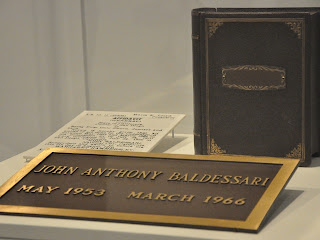New York
What I Saw:
John Baldessari: Pure Beauty
Oct. 20, 2010 – Jan. 9, 2011
Metropolitan Museum of Art
The most extensive retrospective to date of Los Angeles-based artist John Baldessari, Pure Beauty is an exceptionally organized show, offering highlights from every decade of the conceptualist artist’s career. His early use of text, photography and film and the underlying theme of “What makes art, art?” has influenced countless contemporary artists, apparent in the works of Cindy Sherman and Jenny Holzer.
Standout Piece:
In 1970, frustrated with the limitations of his previous work, John Baldessari burned pieces he created between 1953 and 1966. “Cremation Project,” as it became to be known, was not only a disavowal of his previous life as a painter and what came of his efforts, but a definitive moment in Baldessari’s transition towards a more hands-off approach in creating art.
 Image courtesy of DNAinfo/Jennifer Glickel
Image courtesy of DNAinfo/Jennifer Glickel
Pure Beauty was organized by LACMA in association with Tate Modern. It is on view at the MET until Jan. 9, 2011. For more information go here.
What I Drank:
Vodka. And a lot of it. I spent Friday night at a big gay toys for tots benefit and it was open bar. Enough said.

What I Thought:
“Cremation Project” is a lasting testament to the transition in Baldessari’s career and creative process. Maybe the piece resonated so much because I’m in the process of my own career transition. And who hasn’t wanted to burn it all to the ground before.
Dallas
What I Saw:
The Dallas Museum of Art
My first time to the DMA, I was extremely impressed with the facilities, the diversity of the permanent collection and the breadth of community programming.
For visitor information, go here.
Standout Pieces from Re-Seeing the Contemporary (Oct. 15, 2010 - March 20, 2010):
David Szafranski's “Is it Fear or Desire” and Alan Saret's "Deep Forest Green Dispersion"

Deep Forest Green Dispersion, 1969, Alan Saret, American Galvanized hex netting, painted,Dallas Museum of Art, gift of John Weber
What I Drank:
What didn’t I drink?! Delicious margaritas at an excellent authentic Mexican restaurant, bottle after bottle of assorted red wines (bought in a slightly dream like shopping spree at Costco) and Miller Light. From a bottle and from a keg.
What I Thought:
Texas gets a bad rap.













